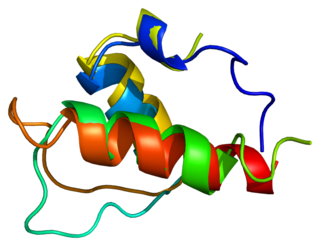Muscular LMNA interacting protein (MLIP) is a protein that in humans is encoded by the MLIP gene. [5]
Muscular LMNA interacting protein (MLIP) is a protein that in humans is encoded by the MLIP gene. [5]
The function of MLIP is not known but it has been suggested that it may have a role in the growth of the heart and heart disease. There is some evidence that MLIP may be involved in maintaining cardiac homeostasis and in the initial reaction to changes in workload. However, a knockout mouse model had normal cardiac function and no structural abnormalities, showing that MLIP is not vital to these processes. [6]
Muscular LMNA interacting protein has a number of aliases including MLIP, C6orf142, CIP and Muscle-enriched A-type Lamin-interacting Protein. [6] [5]
MLIP is located on the short arm of chromosome 6 in humans with the exact locus of 6p12.1. The gene spans 53929982 to 54266280 on the + strand of chromosome 6. [7] It has 19 exons and 13 splice variants ranging in size from 23 to 57 kDa. [8] [9]
MLIP is found only in amniotes (reptiles, birds and mammals), where it is highly conserved. The mouse homologue is 2310046A06rik. [5] [9]
MLIP is expressed throughout the body with higher levels found in the heart and muscle cells. It interacts with the nuclear envelope proteins lamin A/C, which is what led to its discovery. It also interacts with Islet1 transcription factor. [6]

The C3a receptor also known as complement component 3a receptor 1 (C3AR1) is a G protein-coupled receptor protein involved in the complement system.

Lamina-associated polypeptide 2 (LAP2), isoforms beta/gamma is a protein that in humans is encoded by the TMPO gene. LAP2 is an inner nuclear membrane (INM) protein.

Chemokine ligand 21 (CCL21) is a small cytokine belonging to the CC chemokine family. This chemokine is also known as 6Ckine, exodus-2, and secondary lymphoid-tissue chemokine (SLC). The gene for CCL21 is located on human chromosome 9. CCL21 elicits its effects by binding to a cell surface chemokine receptor known as CCR7.

Pre-lamin A/C or lamin A/C is a protein that in humans is encoded by the LMNA gene. Lamin A/C belongs to the lamin family of proteins.

C-C chemokine receptor type 7 is a protein that in humans is encoded by the CCR7 gene. Two ligands have been identified for this receptor: the chemokines ligand 19 (CCL19/ELC) and ligand 21 (CCL21).

Chemokine receptor 6 also known as CCR6 is a CC chemokine receptor protein which in humans is encoded by the CCR6 gene. CCR6 has also recently been designated CD196. The gene is located on the long arm of Chromosome 6 (6q27) on the Watson (plus) strand. It is 139,737 bases long and encodes a protein of 374 amino acids.

CD83 is a human protein encoded by the CD83 gene.

Lymphotoxin-beta (LT-beta) also known as tumor necrosis factor C (TNF-C) is a protein that in humans is encoded by the LTB gene.

Chemokine-binding protein 2 is a protein that in humans is encoded by the CCBP2 gene.

CD93 is a protein that in humans is encoded by the CD93 gene. CD93 is a C-type lectin transmembrane receptor which plays a role not only in cell–cell adhesion processes but also in host defense.

Toll interacting protein, also known as TOLLIP, is an inhibitory adaptor protein that in humans is encoded by the TOLLIP gene.

Transcription factor COE1 is a protein that in humans is encoded by the EBF1 gene. EBF1 stands for Early B-Cell Factor 1.

Zinc finger protein Aiolos also known as Ikaros family zinc finger protein 3 is a protein that in humans is encoded by the IKZF3 gene.

OX-2 membrane glycoprotein, also named CD200 is a human protein encoded by the CD200 gene.

Cell surface transmembrane glycoprotein CD200 receptor 1 is a protein that in humans is encoded by the CD200R1 gene. CD200R1 is expressed on the surface of myeloid cells and CD4+ T cells. It interacts with CD200 transmembrane glycoprotein that can be expressed on variety of cells including neurons, epithelial cells, endothelial cells, fibroblasts, and lymphoid cells.

Signal-regulatory protein beta-1 is a protein that in humans is encoded by the SIRPB1 gene. SIRPB1 has also recently been designated CD172B.

Torsin-1A-interacting protein 1 is a protein that in humans is encoded by the TOR1AIP1 gene. More commonly known as lamina associated polypeptide 1 (LAP1), it is a type II integral membrane protein that resides in the inner nuclear membrane. The luminal domain of LAP1 interacts with Torsin A and is necessary for the ATPase activity of Torsin A. LAP1 plays a critical role in skeletal and heart muscle. Mutations in TOR1AIP1 have been linked to muscular dystrophy and cardiomyopathy. It's deletion from mouse hepatocytes leads to defected very-low density lipoprotein secretion and causes non-alcoholic fatty liver disease and non-alcoholic steatohepatitis

A Disintegrin and metalloproteinase domain-containing protein 8 is an enzyme that in humans is encoded by the ADAM8 gene.

Signal-regulatory protein gamma is a protein that in humans is encoded by the SIRPG gene. SIRPG has also recently been designated CD172G.

Zinc finger protein 239 is a protein that in humans is encoded by the ZNF239 gene.